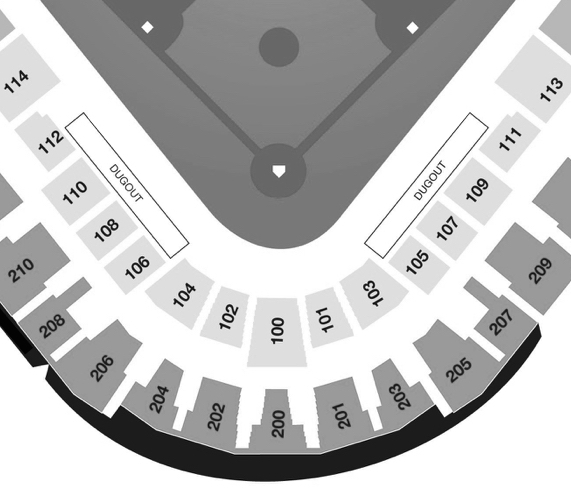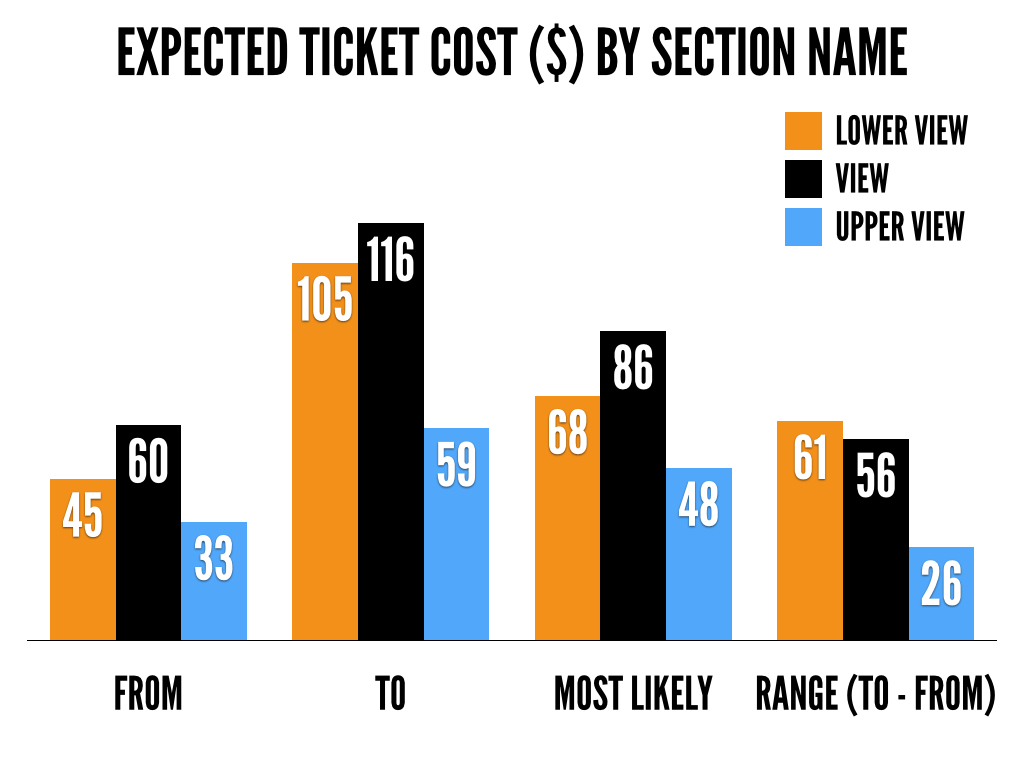I flew out to Arizona last week to watch some spring training baseball. Since I was thinking about baseball and tickets, I wanted to explore the naming of sections within a stadium. In my experience, the naming of sections is not as calculated at it might appear (or should be). In other words, come up with a name for a section that sounds neat or luxurious and run with it. Although this isn’t a spring training example, let’s take a look at Angel Stadium. The Angels have the following section names in their upper deck:
Upper View
View All-Star
View MVP
Lower View Box
Lower View All-Star
Lower View MVP
The naming seems somewhat inconsistent. The “Upper View” designation doesn’t seem to align with anything else. That same section in the lower portion of the upper deck is “Lower View Box”. So why no “View Box”? Or if they want to go with the “Upper View” convention, why no “Upper View All-Star”? This type of inconsistency (and curiosity) led me to this week’s question:

Imagine you are looking at tickets to go to a baseball game (see seating chart above) and have settled on seats in the following section:
VIEW 200
Please indicate how much you would expect to pay for one ticket in that section:
From $_________ to $_________ but most likely $_________.
Please enter numbers only below.
Some of you saw the section referred to as VIEW 200 (above). Others saw UPPER VIEW 200 or LOWER VIEW 200**. Why did I want to test those variations? As I mentioned above, I often see different naming conventions in seating charts and those three are somewhat common. Furthermore, I am very interested in how subtle word cues (ex. upper versus lower) alter perceptions. So what happened when I changed the names of the section?
I’ll preface the chart with an acknowledgment (as I do in all my #1QFriday posts) that these results could happen by chance given the small(ish) number of responses and lack of statistical analysis. What does “by chance” mean? It means if I ran the study again the results may be different. That being said, I strongly believe that paying attention to the naming of sections (or other products/categories in your business) is very important.

Most Likely. What is particularly interesting, and unexpected, is that people expected to pay more for seats in View 200 than Lower View 200. The assumption is that “lower” means seats are closer to the field and thus the expected cost should be higher. That was not the case. Why? It could have happened by chance. Or…the word “lower” may cue different responses (ex. the stadium is trying to scam me), resulting in a negative reaction and lower expected ticket cost.
Range. The reason I had the from $_____ to $_______ setup of the question was to gauge the range people would expect to pay. As shown in the chart, when people saw upper view, they expected to pay somewhere between $33 and $59 (a range of $26) but when they saw lower view they expected to pay between $60 and $116 (a range of $56). Why does this matter? Who cares? Because using a particular word may narrow the range a consumer expects to pay and influence their reaction to the price. For example, if I hear “upper view” my expectation of what I will pay may be much narrower so there is a better chance the posted price may fall outside my range of willingness to pay.
Although the #1QFriday question this week focused on the naming of sections, it could apply to any scenario in which we label a category of things. For example, some restaurants have large sodas and small sodas. Some have large, medium, *and* small. Some have regular and large. You might think these are meaningless names. I would argue they have the potential to change perceptions of willingness to pay or even willingness to consider that particular category/name as an option. Words are very, very, powerful.
Do me a favor and answer this one question: Does your business have some sort of naming convention for your products/service? For example, small/medium/large, view/lower view/upper view. I would love to hear what you name various categories in your business.
**I received a few responses on Twitter asking me “Are we supposed to consider it as an upper deck?” or “What kind of baseball game is it? MLB? NCAA?” My response was it doesn’t really matter. Why? It really didn’t matter because I’m not interested in pricing a section…I was interested in the difference between the various sections (upper view, view, lower view). Every person was randomly assigned to one of the three conditions so random assignment takes care of knowledge issues. For example, let’s assume 12 people thought it was MLB, 12 thought it was Minor League Baseball and 12 thought it was NCAA. Because everyone was randomly assigned to one of the three conditions, on average, I should have ended up with 4 people who thought it was MLB, 4 people who thought it was Minor League Baseball and 4 people who thought it was NCAA in each condition. Thus, any confusion with the scenario would be spread across the three conditions and any differences (ex. Upper View vs. View) would still be meaningful. Could more knowledge change the results? Sure. A person with season tickets might have a better understanding of expected prices than a person who has never been to a game. Although it is important to consider, it was not the point of the study though.
_______
#1QFriday is a blog series that includes my random thoughts and musings. I do not claim to be the first person to think of these things or deny that others have done research on them. I am simply discussing interesting marketing, psychology and linguistic topics that come to mind. Furthermore, I am avoiding fancy statistical analysis as I want the emphasis to be on the ideas. I recently read (Amazon affiliate link) Paul Grice: Philosopher and Linguist and was inspired by a less statistical and more philosophical approach. Thus, the results here could happen by chance. I want to focus on thinking about, discussing and debating the ideas at a broad level rather than whether or not the differences are statistically meaningful. I typically send out a quick survey on Friday and post an analysis/discussion the following week.